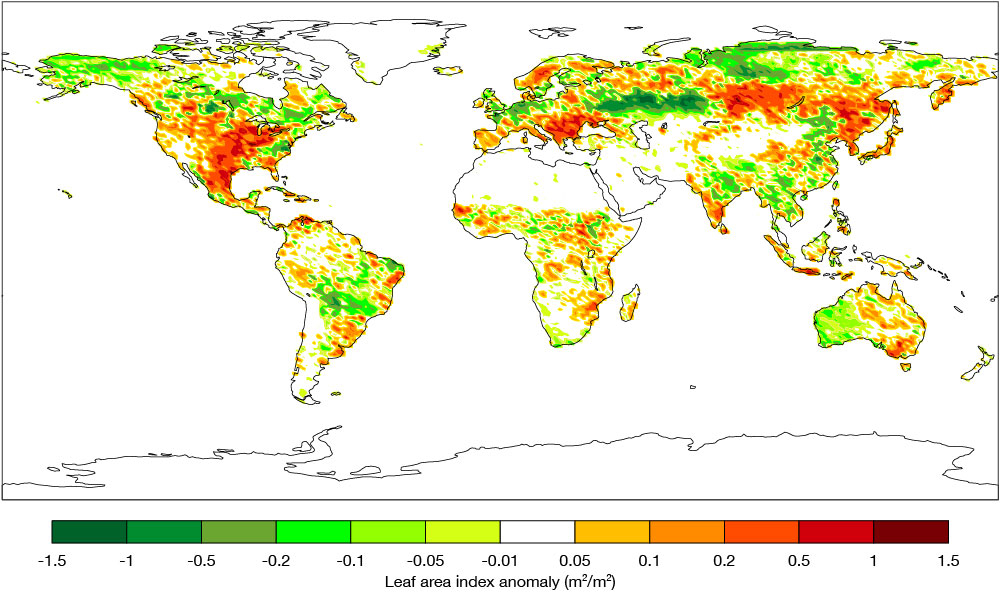CONFESS is a European Horizon 2020 project initiated in 2020 that aims to provide a consistent representation of boundary forcings in reanalyses and seasonal forecasts (https://confess-h2020.eu/). It is intended to evolve the capabilities of the EU‑funded Copernicus Climate Change Service (C3S), run by ECMWF, to monitor and predict extreme events and represent climate trends. CONFESS has three main strategic objectives:
- introduce for the first time temporal variations of land cover and vegetation in C3S systems by exploiting state-of-the-art Copernicus observational datasets
- improve temporal representation of tropospheric aerosols by harmonising datasets from the Coupled Model Intercomparison Project Phase 6 (CMIP6) and the EU’s Copernicus Atmosphere Monitoring Service (CAMS) run by ECMWF
- increase predictive skill by inclusion of prognostic vegetation and new capabilities for responding to volcanic and biomass burning emissions.
Together with project partners Météo-France, Italy’s Institute of Atmospheric Sciences and Climate (CNR-ISAC), and the Barcelona Supercomputing Center (BSC), CONFESS developments are being tested in a multi-model framework to assess the robustness of the results. This article reports on some of ECMWF’s efforts over the past two years targeting the inclusion in the next generation of C3S reanalyses and seasonal forecasts. Beyond the immediate implementation, developments in CONFESS will prepare the ground for the rapid uptake of new Earth observations, thus supporting the continuous evolution of monitoring and forecasting systems used for operational seamless predictions and Copernicus services.
Land cover, use and vegetation
Land cover and vegetation observations are of paramount importance to properly constrain the land surface models that are included in current reanalysis and seasonal-to-decadal prediction systems.
ECMWF has produced a harmonised temporal record spanning the period 1993–2019 of Land Cover (LC), Land Use (LU) and Leaf Area Index (LAI) by merging records from C3S and the Copernicus Global Land Services (CGLS). The first figure shows an example of the anomaly in LAI in July 2010 from the harmonised datasets.

These temporal records have been implemented in different Land Surface Models (LSM), namely ECLand at ECMWF, Surfex at Météo-France and the EC-Earth HTESSEL-LPJGuess. With each LSM, pairs of offline simulations, driven by atmospheric forcing using ECMWF’s ERA5 reanalysis, have been conducted with and without time-varying land properties. The sensitivity of water and energy fluxes to the temporal land variations have been evaluated and verified against available observations. The multi-model assessment makes it possible to quantify the uncertainty arising from differences in model configuration and parametrizations. Results show that anomalously low LAI conditions, such as those during the European drought in 2003 and the Russian heatwave in 2010, consistently decrease latent heat flux and increase sensible heat flux, in agreement with observations. This response is likely to impact the estimation and prediction of extremes.
Aerosol forcing
Decadal variations of tropospheric aerosols (see the black carbon figure as an example) can have a strong impact on the production of reanalyses and seasonal re‑forecasts. Currently, ERA5 and ECMWF’s seasonal forecasting system (SEAS5) use tropospheric sulphate aerosol forcing from CMIP5, which is outdated and not consistent with the aerosol climatology used in numerical weather prediction (NWP). In preparation for ERA6 and SEAS6, CONFESS has produced a homogenous and consistent multi-decadal record of tropospheric aerosols, exploiting the atmospheric composition capabilities that CAMS has introduced into ECMWF’s Integrated Forecasting System (IFS). A time-varying climatology of multiple aerosol species is calculated based on data from a multi-decadal set of Cycle 47r3 IFS-COMPO forecasts constrained by ERA5 meteorology, and with continuously evolving chemistry and aerosols driven by specified emissions. So far, we have considered the periods 1971–2019 forced by CMIP6-style emission data, and 2003–2020 forced by CAMS emissions. Creating data back to 1940 will be straightforward using the newly created ERA5 reanalysis for that period. The aerosol records are then smoothed with a nine-year running mean to represent decadal variability. The resulting product has the added advantage that the last nine years can be used as a representation of the current climate aerosol values for NWP. We plan to use the resulting forcing fields in the IFS cycle used for the next generation of ECMWF seasonal forecasts SEAS6 and the upcoming C3S reanalysis ERA6. Having an up-to-date aerosol climatology that is consistent with the latest CAMS aerosols also helps us to benchmark the impact of interactive aerosols on NWP.

